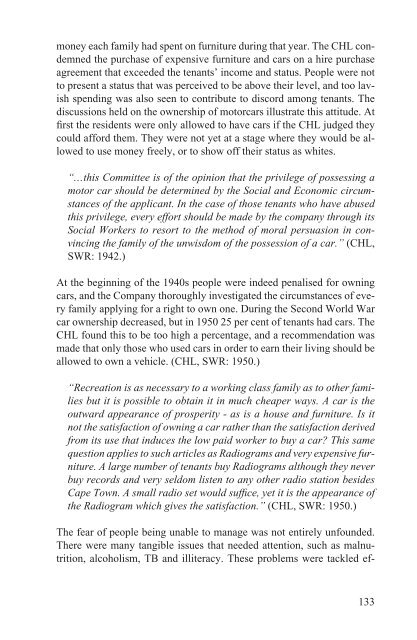The Making of a Good White - E-thesis - Helsinki.fi
The Making of a Good White - E-thesis - Helsinki.fi
The Making of a Good White - E-thesis - Helsinki.fi
Create successful ePaper yourself
Turn your PDF publications into a flip-book with our unique Google optimized e-Paper software.
money each family had spent on furniture during that year. <strong>The</strong> CHL condemned<br />
the purchase <strong>of</strong> expensive furniture and cars on a hire purchase<br />
agreement that exceeded the tenants’ income and status. People were not<br />
to present a status that was perceived to be above their level, and too lavish<br />
spending was also seen to contribute to discord among tenants. <strong>The</strong><br />
discussions held on the ownership <strong>of</strong> motorcars illustrate this attitude. At<br />
<strong>fi</strong>rst the residents were only allowed to have cars if the CHL judged they<br />
could afford them. <strong>The</strong>y were not yet at a stage where they would be allowed<br />
to use money freely, or to show <strong>of</strong>f their status as whites.<br />
“…this Committee is <strong>of</strong> the opinion that the privilege <strong>of</strong> possessing a<br />
motor car should be determined by the Social and Economic circumstances<br />
<strong>of</strong> the applicant. In the case <strong>of</strong> those tenants who have abused<br />
this privilege, every effort should be made by the company through its<br />
Social Workers to resort to the method <strong>of</strong> moral persuasion in convincing<br />
the family <strong>of</strong> the unwisdom <strong>of</strong> the possession <strong>of</strong> a car.” (CHL,<br />
SWR: 1942.)<br />
At the beginning <strong>of</strong> the 1940s people were indeed penalised for owning<br />
cars, and the Company thoroughly investigated the circumstances <strong>of</strong> every<br />
family applying for a right to own one. During the Second World War<br />
car ownership decreased, but in 1950 25 per cent <strong>of</strong> tenants had cars. <strong>The</strong><br />
CHL found this to be too high a percentage, and a recommendation was<br />
made that only those who used cars in order to earn their living should be<br />
allowed to own a vehicle. (CHL, SWR: 1950.)<br />
“Recreation is as necessary to a working class family as to other families<br />
but it is possible to obtain it in much cheaper ways. A car is the<br />
outward appearance <strong>of</strong> prosperity - as is a house and furniture. Is it<br />
not the satisfaction <strong>of</strong> owning a car rather than the satisfaction derived<br />
from its use that induces the low paid worker to buy a car? This same<br />
question applies to such articles as Radiograms and very expensive furniture.<br />
A large number <strong>of</strong> tenants buy Radiograms although they never<br />
buy records and very seldom listen to any other radio station besides<br />
Cape Town. A small radio set would suf<strong>fi</strong> ce, yet it is the appearance <strong>of</strong><br />
the Radiogram which gives the satisfaction.” (CHL, SWR: 1950.)<br />
<strong>The</strong> fear <strong>of</strong> people being unable to manage was not entirely unfounded.<br />
<strong>The</strong>re were many tangible issues that needed attention, such as malnutrition,<br />
alcoholism, TB and illiteracy. <strong>The</strong>se problems were tackled ef-<br />
133
















